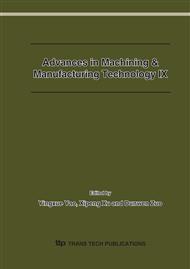p.163
p.168
p.172
p.177
p.182
p.187
p.192
p.197
p.201
The Influence of Material Constitutive Constants on Numerical Simulation of Orthogonal Cutting of Titanium Alloy Ti6Al4V
Abstract:
Johnson-Cook (JC) constitutive model is extensively used in the simulation of metal machining. There are several different sets of JC material constants for titanium alloy Ti6Al4V fitted by split-Hopkinson bar (SHPB) tests. However, few researches have been done to study their sensitivity on the behavior of cutting. In this work, four different sets of material constants were performed in a 2D numerical model to simulate the cutting process of titanium alloy Ti6Al4V. The effects of the four sets of material constants on the predicted cutting forces, chip morphology and temperature were studied. It is shown that all the considered process outputs are very sensitive to material constitutive constants. Some quantitive comparisons with experimental results reported in the literature were also made.
Info:
Periodical:
Pages:
182-186
Citation:
Online since:
March 2008
Authors:
Keywords:
Price:
Сopyright:
© 2008 Trans Tech Publications Ltd. All Rights Reserved
Share:
Citation:


